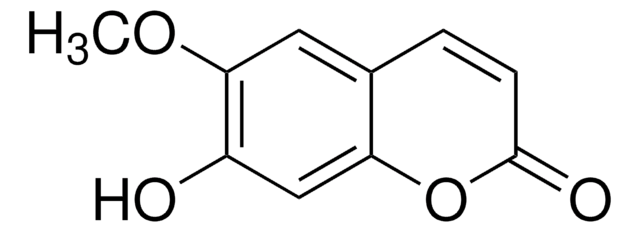48640
Ethyl gallate
antioxidant, ≥96.0% (HPLC)
Sinónimos:
3,4,5-Trihydroxybenzoic acid ethyl ester, Ethyl 3,4,5-trihydroxybenzoate, Progallin A
About This Item
Productos recomendados
assay
≥96.0% (HPLC)
form
solid
SMILES string
CCOC(=O)c1cc(O)c(O)c(O)c1
InChI
1S/C9H10O5/c1-2-14-9(13)5-3-6(10)8(12)7(11)4-5/h3-4,10-12H,2H2,1H3
InChI key
VFPFQHQNJCMNBZ-UHFFFAOYSA-N
¿Está buscando productos similares? Visita Guía de comparación de productos
General description
Application
- Wound healing enhancement: Ethyl gallate, isolated from Caesalpinia mimosoides, demonstrated significant effects in promoting cutaneous wound healing. This discovery supports its potential application in therapeutic treatments for skin regeneration (Bhat et al., 2023).
- Pharmacokinetics in ethanolic extracts: A study involving ethanolic extracts of Terminalia chebula, which include ethyl gallate, detailed the pharmacokinetics of these active compounds in rats, providing critical data for pharmaceutical applications and drug development processes (Yao et al., 2023).
- Ethnopharmacology research: Research on Rubus idaeus, a source of ethyl gallate, covered extensive ethnobotany, phytochemical, and pharmacological aspects, offering insights into traditional uses and modern applications, highlighting its potential in ethnopharmacology (Tao et al., 2023).
- Dermal applications: Ethyl gallate was used in a topical ointment from Caesalpinia mimosoides to attenuate dermal wounds. This application underscores its effectiveness in skin care and treatment strategies (Bhat et al., 2022).
- Neuroprotective effects: The Jingchuan tablet, which includes ethyl gallate, has been studied for its therapeutic role in treating ischaemic cerebral stroke, focusing on the HIF-1α/EPO/VEGFA signalling pathway. This research outlines its importance in neuroprotective strategies (Zhang et al., 2022).
Storage Class
11 - Combustible Solids
wgk_germany
WGK 2
flash_point_f
Not applicable
flash_point_c
Not applicable
ppe
Eyeshields, Gloves, type N95 (US)
Certificados de análisis (COA)
Busque Certificados de análisis (COA) introduciendo el número de lote del producto. Los números de lote se encuentran en la etiqueta del producto después de las palabras «Lot» o «Batch»
¿Ya tiene este producto?
Encuentre la documentación para los productos que ha comprado recientemente en la Biblioteca de documentos.
Los clientes también vieron
Protocolos
HPLC Analysis of Polyphenols in Nero d'Avola Red Wine on Discovery® HS C18 (UV 280 nm)
Nuestro equipo de científicos tiene experiencia en todas las áreas de investigación: Ciencias de la vida, Ciencia de los materiales, Síntesis química, Cromatografía, Analítica y muchas otras.
Póngase en contacto con el Servicio técnico




